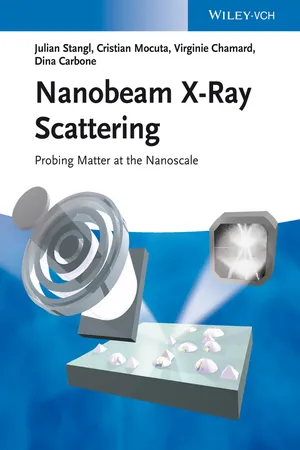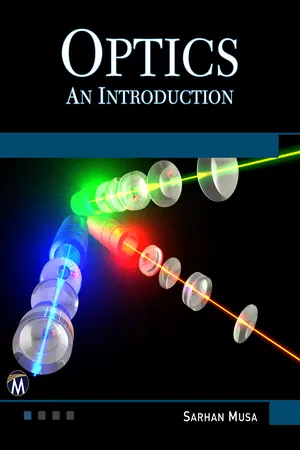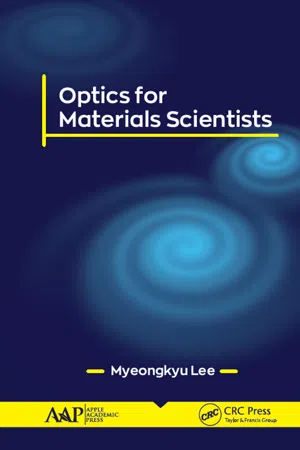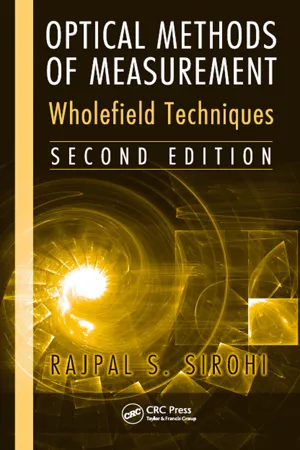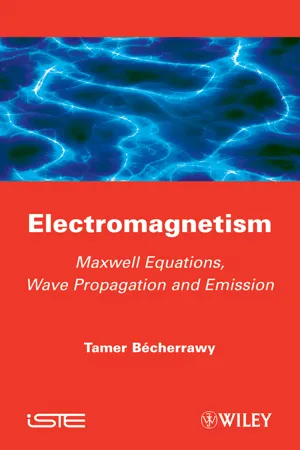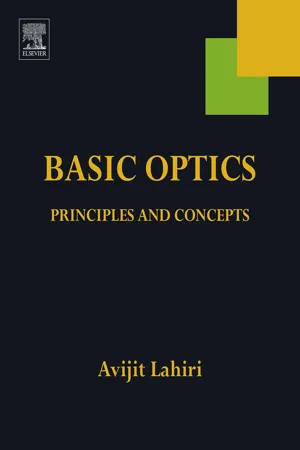Physics
Diffraction
Diffraction refers to the bending of waves around obstacles and the spreading of waves as they pass through narrow openings. In the context of physics, it is a phenomenon that occurs with all types of waves, including sound, light, and water waves. Diffraction patterns can be observed when waves encounter obstacles or pass through slits, leading to the spreading and interference of the wave fronts.
Written by Perlego with AI-assistance
Related key terms
Related key terms
1 of 4
Related key terms
1 of 3
12 Key excerpts on "Diffraction"
- Douglas B. Murphy, Michael W. Davidson(Authors)
- 2012(Publication Date)
- Wiley-Blackwell(Publisher)
Fig. 5.1 ). In the microscope, light from the illuminator is diffracted (literally broken up in the sense of being scattered or spread) by the specimen, collected by the objective (a second site for Diffraction), and focused in the image plane, where waves constructively and destructively interfere to form a contrast image. In fluorescence imaging, waves of fluorescent light experience Diffraction in the front aperture of the objective. The scattering of light (Diffraction) and its recombination (interference) are phenomena of physical optics or wave optics. We study these processes because they demonstrate how light, carrying information from an object, is able to create an image in the focal plane of a lens. With a working knowledge of Diffraction, we understand why adjusting the condenser aperture and using oil immersion techniques affect spatial resolution. Diffraction theory also teaches us that there is a limit beyond which a lens cannot resolve fine spatial features in an object. In studying Diffraction, we see that complex optical phenomena can be understood in mathematically precise and simple terms, and we come to appreciate the microscope as a sophisticated optical instrument. Readers interested in the physical optics of Diffraction and interference of light can refer to the excellent texts by Hecht (2001) and Pluta (1988).Figure 5.1 Diffraction image of a copper mesh grid. A 400-mesh grid was illuminated with a laser pointer, and its Diffraction pattern was photographed on a projection screen. Multiple Diffraction spots are observed due to the relatively large spacing between grid bars and the coherent laser light source.Diffraction AND INTERFERENCE
Diffraction is the spreading of light that occurs when a beam of light interacts with an object. Depending on the circumstances and type of specimen, diffracted light is perceived in different ways. For example, when a beam of light is directed at the edge of an object, light appears to bend around the object into its geometric shadow, a region not directly illuminated by the beam (Fig. 5.2 a). The situation reminds us of the behavior of water waves incident on a log floating in a pond. The waves wrap around the ends of the log into the geometrical shadow; instead of reflecting away from the ends of the log, they seem to grab hold of the ends and swing themselves around into the sheltered zone.Figure 5.2 Diffraction at an aperture and at a specimen with fine particles. (a) The electric field of a planar wavefront becomes disturbed by Diffraction upon passage through an aperture. The waves appear to grab hold of the aperture and swing around into its geometric shadow. The amplitude profile of a transmitted wavefront is also no longer uniform and remains permanently altered after passage through the aperture (not shown). (b) A substrate containing a layer of a mixture of fine particles (0.2- and 2-µ m diameter) diffracts an incident planar wavefront into scattered beams that diverge at different angles. The angle of spreading (θ ) is inversely proportional to the size of the particles, so θ 1- eBook - ePub
- Cesar A. Sciammarella, Federico M. Sciammarella(Authors)
- 2012(Publication Date)
- Wiley(Publisher)
This concept can be extended to N sources. It is important to understand that the previous operations are formal operations of the representation of the functions that are utilized by phasors and are not connected to the vectorial nature of the propagating light. A phasor as it is utilized in this context is related to the fact that the propagating waves were analyzed in the scalar theory of light. The fact that there are two components of the scalar wave, amplitude and phase leads to the representation in two dimensions with complex functions. The complex representation is only valid in two dimensions and cannot be extended to the 3D space.7.5 Diffraction of the LightThe Diffraction of light is a very important aspect of the theory of light and includes a very wide range of subjects. Broadly speaking it deals with the interaction of light with objects that are in the path of propagating beams. Looking from the mathematical point of view and considering the Maxwell equations it deals with the boundary conditions that are required to get solutions of the equations. Wave fronts arrive at an object and interact with the object by changing the magnetic and the electrical field of the object. The new generated fields interact with the propagating field modifying it and the changes in general will depend on the distance of the region of observation with respect to the boundary of the object.The mathematical problems that arise from this interaction are extremely difficult to solve. The objects with which the wave fronts interact can be very large or very small. For example, objects can be in the order of magnitude of the wavelength of light or even smaller. The effects of Diffraction are more striking when the objects are small. The Diffraction phenomena depend on the type of objects that the light interacts with, whether they are dielectric or conductors. Since light is a propagating electromagnetic field it will interact with the atomic structure of the bodies that it encounters. If the body is a conductor, it will set up local electro-magnetic changes in the region that it illuminates. In turn these local changes will cause changes in the propagating beam. The complex patterns that are produced by interaction of waves that are diffracted are a consequence of the superposition, or interference, of different parts of a wave that reach the observation plane by different paths.Figure 7.15 - eBook - ePub
Nanobeam X-Ray Scattering
Probing Matter at the Nanoscale
- Julian Stangl, Cristian Mocuta, Virginie Chamard, Dina Carbone(Authors)
- 2013(Publication Date)
- Wiley-VCH(Publisher)
2
X-ray Diffraction Principles
In this chapter some basic concepts and nomenclature of Diffraction are introduced to make the book self-consistent and to provide a formal framework for the understanding of the experimental issues discussed later in this book. There exist many well-written books on Diffraction [3, 4], and the reader who is interested in a deeper understanding of the subject is referred to them. Our choice is to keep this introduction very informative to benefit the reader who has little familiarity with this topic.2.1 A Brief Introduction to Diffraction Theory
2.1.1 Interference of X-ray Waves
The basic concept behind X-ray Diffraction is the elastic scattering of an electromagnetic wave by the electrons present in the sample. An X-ray wave is scattered elastically if the scattering process does not cause a change of its wavelength, but only of its direction. The elastic scattering, therefore, is a conserving process, that is it does not involve any energy loss, neither by transfer of energy to the electrons, nor by generation of electronic or phonon excitation of the sample.X-rays, as electromagnetic waves, are described by a wave vector k (cf. Figure 2.1 ), related to the wavelength λ by the following relation:(2.1)where λ depends on the energy E (for X-rays typically in the range of 102 –105 eV) in the following way:(2.2)with h and c being the universal constant and the speed of light, respectively.Figure 2.1 The electric and magnetic fields are mutually perpendicular, and perpendicular to the propagation direction k . The wavelength λ is highlighted as a distance between two consecutive maxima of the electric (magnetic) field.The phenomenon of Diffraction consists of the interference of waves elastically scattered by all the electrons present in the material illuminated by the radiation. This interference produces an angular distribution of intensity of radiation that holds information about density and distribution of electrons inside the specimen. - eBook - ePub
Optics
An Introduction
- Sarhan M. Musa(Author)
- 2020(Publication Date)
- Mercury Learning and Information(Publisher)
If the shadow of the obstacle is received at C on a screen, it is observed that the boundary of the shadow is never sharp. A small portion of light has “bent” around the edge into the geometrical shadow; outside the shadow parallel to its edge are observed several bright and comparatively dark bands. FIGURE 10.1. Geometrical shadow of a straight edge. The term Diffraction is applied to all phenomena like this which are produced whenever there is any limitation on the width of the beam of light. Since in most Diffraction patterns some light penetrates within the region of geometrical shadow, Diffraction is sometimes defined as “the bending of light around an obstacle.” This phenomenon was first discovered in 1665 by an Italian scientist named Grimaldi, and was later on studied by Newton. In the days when corpuscular theory was prevalent, attempts were made by Newton to interpret Diffraction effects as due to attractive or repulsive forces exerted by the edges of obstacles on flying corpuscles, so as to deflect them from their rectilinear path. In terms of wave theory, the first attempt to explain the Diffraction phenomenon was made by Dr. Young, who attributed it to the interference between the direct light waves which pass near the edge of the obstacle and the wave of light reflected at grazing incidence from the edge. This explanation could scarcely be applied to explain the penetration of light within the region of geometrical shadow. Moreover, the maxima and minima regions are not equally spaced as demanded by the mode of interference imagined by Young. Even then if we accept Young’s explanation to be correct, the intensity distribution on the screen should depend upon (a) the sharpness of the edge, (b) its degree of polish, and (c) its material - eBook - ePub
- Frank J. Fahy(Author)
- 2000(Publication Date)
- Academic Press(Publisher)
regularly spaced , small, discrete bodies produce directional scattering that is classified as ‘Diffraction’ because the scattered field is ordered, unlike that reflected by randomly distributed scatterers. The form of the diffracted field is a function of the geometry of the array and the ratio of wavelength to spacing. X-ray Diffraction analysis of the structures of materials is based upon this principle. Impulsive sound scattered by railings comprising parallel bars or surfaces having periodic, non-plane profiles, is tonally coloured because components of different frequencies are scattered into different distinct directions.Many solid bodies possess sharp edges and corners, such as those of box-like loudspeaker cabinets. The process by which such an impedance discontinuity produces a secondary field that interferes with the incident field to produce a systematic deformation of the wavefronts is termed ‘Diffraction’. The discontinuity acts as a secondary source, not because it generates sound, but because the diffracted field spreads out from it, as it does from an active source. Examples of wave Diffraction are shown in Figs 2.9 and 2.10 . Diffraction around the breakwater model shown in Fig. 2.10 is not strictly analogous to acoustic Diffraction around the edge of a screen because it is the longer acoustic wavelengths that invade the ‘shadow’ zone more strongly. Diffraction also accounts for the fact that sound transmitted through an aperture that is small compared with a wavelength spreads out more or less omnidirectionally.Both scattering and Diffraction are caused by the disruption of incident wavefronts by the presence of impedance disparities. The secondary fields so caused are generally complex in form and vary greatly with wavelength. The mathematical analysis of scattering and Diffraction involves advanced techniques with which the reader will probably not be familiar. Therefore only a few simple cases are analysed mathematically, and much of the exposition is qualitative.Wavefronts are distorted when passing through regions in which the speed of sound or the flow speed varies with position. Where the spatial variations are ‘slow’ on the scale of a wavelength, the wavefronts remain intact but their shapes and headings vary as they propagate. This phenomenon is known as ‘refraction’. In cases where the sound speed or flow speed varies on a scale comparable with, or smaller than, a wavelength and/or frequency, the process of fragmentation of wavefronts is termed ‘scattering’. This effect is easily observed by listening carefully to the sound of an aircraft overflying at great height. The acoustic wavefronts are fragmented by the turbulent motion and temperature non-uniformities of the atmosphere. - eBook - ePub
- Grant R. Fowles(Author)
- 2012(Publication Date)
- Dover Publications(Publisher)
CHAPTER 5Diffraction
5.1 General Description of Diffraction
If an opaque object is placed between a point source of light and a white screen, it is found that the shadow that is cast by the object departs from the perfect sharpness predicted by geometrical optics. Close examination of the shadow edge reveals that some light goes over into the dark zone of the geometrical shadow and that dark fringes appear in the illuminated zone. This “smearing” of the shadow edge is closely related to another phenomenon, namely, the spreading of light after passing through a very small aperture, such as a pinhole or a narrow slit, as in Young’s experiment. The collective name given to these departures from geometrical optics is Diffraction .The essential features of Diffraction phenomena can be explained qualitatively by Huygens’ principle. This principle in its original form states that the propagation of a light wave can be predicted by assuming that each point of the wave front acts as the source of a secondary wave that spreads out in all directions. The envelope of all the secondary waves is the new wave front.We shall not attempt to treat Diffraction by a direct application of Huygens’ principle. We want a more quantitative approach. Our strategy will be to cast Huygens’ principle into a precise mathematical form known as the Fresnel- Kirchhoff formula . This formula will then be applied to various specific cases of Diffraction of light by obstacles and apertures.5.2 Fundamental Theory
Let us recall Green’s theorem14 that states that if U and V are any two scalar-point functions that satisfy the usual conditions of continuity and integrability, then the following equality holds:(5.1)The left-hand integral extends over any closed surface , and the right-hand integral includes the volume within that surface. By “gradn - Tamer Bécherrawy(Author)
- 2013(Publication Date)
- Wiley-ISTE(Publisher)
Chapter 8Interference and DiffractionIf two beams of particles are intercepted on the same region of a screen, the energy, momentum and other physical quantities, which are received at each point, are the sums of the corresponding quantities for the beams if they are intercepted separately. This is not the case if two waves superpose in a region of space; the experiment shows that there is a redistribution of physical quantities. We say that the waves interfere . On the other hand, a free particle has rectilinear motion even if it passes near a body or through an aperture with which it does not interact. The experiment shows that a wave deviates from its straight-line propagation if it encounters an obstacle, or it passes through an aperture whose dimensions are comparable to the wavelength. This effect is known as Diffraction . Interference and Diffraction are two characteristic properties of waves; they are consequences of the superposition principle of waves and the quadratic dependence of the physical quantities on u .In this chapter we study the interference and Diffraction of mechanical and electromagnetic waves. In the case of vector waves, we assume that they are either longitudinal or transverse but polarized linearly in the same direction; this allows us to replace their vector sums by algebraic sums, just like in the case of scalar waves. We will not discuss the questions that are specific to optics, such as coherence, interference setups, effects of Diffraction on the formation of images, polarization, etc.8.1. Order and fringes of interference of two waves
Consider two waves with equal frequencies and equal amplitudes, that are emitted by two sources S 1 and S 2 at a sufficiently long distance from the region of observation, so that the amplitude of the waves varies little in this region (Figure 8.1a ). By “sources”, we mean either the emitters of the waves or two small apertures through which the waves pass before their superposition at a point M . If a wave travels a distance r in a homogeneous medium, it undergoes a phase lag ωr/v , were v is the speed of propagation. If the waves at the sources are u 1 = A cos(ωt −ϕ1 ) and u 2 = A cos(ωt − ϕ2 ), their expressions at M are u 1 = A cos[ω(t − r 1 /v ) − ϕ1 ] and u 2 = A cos[ω(t − r 2 /v ) − ϕ2 ], where r 1 and r 2 are the distances of M to the sources, measured along the wave path. The phases ϕ1 and ϕ2 of the sources may always be chosen in such a way that the amplitudes are positive. The resultant wave at M- eBook - ePub
- Myeongkyu Lee(Author)
- 2019(Publication Date)
- Apple Academic Press(Publisher)
Although there are some limitations and different views as to whether it accurately represents reality, this principle is consistent with many experimental observations and can explain Diffraction effects fairly well. A common example of Diffraction is the spreading out of a wave passing through a small aperture. This is explained by the Huygens–Fresnel principle in Figure 5.3. While there are numerous point sources on the incident wavefront, secondary waves only from some points ahead of the aperture can pass through it and those from the others are blocked. As the aperture gets smaller, the number of unobstructed points decreases. Thus, the incoming wave is more widely spread on passing through a smaller aperture. FIGURE 5.2 Application of Huygens’ principle to the law of refraction. If the aperture is a very narrow, long slit, a cylindrical wave will emerge (Fig. 5.4a). Young’s double-slit experiment is slightly modified in Figure 5.4b, where a plane wave falls on two narrow, parallel, and closely spaced slits. Two cylindrical waves coming from the slits are always in phase along certain directions and 180° out of phase along some others. If a screen is placed far away from the slits, alternating bright and dark fringes will appear on the screen. We here see that there is no physical difference between interference and Diffraction. When a beam of light is focused by a lens, the beam size at focus is decreased as the focal length of the lens decreases. Since the beam shape is symmetric with respect to the focal point (refer to Fig. 1.7), a more tightly focused beam is more widely spread. Assuming that the areal density of point sources is constant, a small beam containing a limited number of sources will be highly divergent. As the beam size increases, the number of point sources increases as much, thus producing more secondary waves - eBook - ePub
- R. W. Ditchburn(Author)
- 2013(Publication Date)
- Dover Publications(Publisher)
equation 6(13) . A further extension of Diffraction theory to cases where the obstacles are not all in one surface may also be made. This “three-dimensional Diffraction” is of great importance in connection with the Diffraction of X-rays by crystals and has been studied by Laue and others.In the theory of X-ray Diffraction the energy diffracted in a given direction is shown to be proportional to the product of two factors. One factor (called the “structure factor”) depends on the distribution of the atoms in the unit cell; the other factor depends on the arrangement of the cells (i.e. upon the space-group). The problem is analogous to the optical problem discussed in §§ 6.18 –6.20 .6.26. Laws of Rectilinear Propagation, Reflection and Refraction.In § 6.11 we saw that when the width of the beam was very large compared with the wavelength of the radiation, the energy was very small except in the direction defined by κy = 0. Thus, after passing a very wide aperture, nearly all the energy continues to travel in the direction of the incident wave. Equation 6(52) shows that this is still true when the wave strikes the aperture obliquely. Applying the argument of § 6.24 to a beam falling obliquely upon a reflecting aperture, it may be shown that the favoured direction is now that for which ky = — ky ′, i.e. a direction which makes the same angle with the normal as the incident direction, but on the opposite side of the normal. Finally, referring to equation 6(51) , we see that when the Diffraction screen separates two media of different refractive indices (n1 and n2 ), the centre of the pattern is located in a direction defined byorThus in each case the centre of the Diffraction pattern lies in the direction predicted by the ordinary laws of rectilinear propagation, of reflection and of refraction. The theory of Diffraction thus includes these laws as limiting relations, valid for indefinitely wide beams.6.27. Diffraction Gratings.Any regular arrangement of similar apertures constitutes a Diffraction grating, but one particular type of Diffraction grating is of special importance in optics. This grating consists of a series of parallel lines ruled on glass or metal and spaced at equal intervals. A simple grating of this type may be made by covering a glass plate with an opaque layer of silver and then ruling parallel lines in the silver. The silver is removed by the needle, and clear spaces are left. This method produces a grating in which the clear spaces have a very high transmission, while the opaque spaces have nearly zero transmission, provided that the lines are not too close. Following the procedure explained in § 6.25 and substituting (k1 — k2 ) for κy in equation 6(35) - eBook - ePub
Optical Methods of Measurement
Wholefield Techniques, Second Edition
- Rajpal Sirohi(Author)
- 2018(Publication Date)
- CRC Press(Publisher)
3 DiffractionIn an isotropic medium, a monochromatic wave propagates with its characteristic speed. For plane and spherical waves, if the phase front is known at time t = t1 , its location at a later time is obtained easily by multiplying the elapsed time by the velocity in the medium. The wave remains either plane or spherical. Mathematically, we can find the amplitude at any point by solving the Helmholtz equation (Equation 1.3 ). However, when the wavefront is restricted in its lateral dimension, Diffraction of light takes place. Diffraction problems are rather complex in nature, and analytical solutions exist for only a few of them. The Kirchhoff theory of Diffraction, although afflicted with inconsistency in the boundary conditions, yields predictions that are in close agreement with experiments.The term “Diffraction” has been conveniently described by Sommerfeld as “any deviation of light rays from rectilinear paths that cannot be interpreted as reflection or refraction.” It is often stated in a different form as “bending of rays near the corners.” Grimaldi first observed the presence of bands in the geometrical shadow region of an object. A satisfactory explanation of this observation was given by Huygens by introducing the concept of secondary sources on the wavefront at any instant and obtaining the subsequent wavefront as an envelope of the secondary waves. Fresnel improved upon the ideas of Huygens, and the theory is known as the Huygens–Fresnel theory of Diffraction.This theory was placed on firmer mathematical ground by Kirchhoff, who developed his mathematical theory using two assumptions about the boundary values of the light incident on the surface of an obstacle placed in its path of propagation. This theory is known as Fresnel–Kirchhoff Diffraction theory. It was found that the two assumptions of Fresnel–Kirchhoff theory are mutually inconsistent. The theory, however, yields results that are in surprisingly good agreement with experiments in most situations. Sommerfeld modified Kirchhoff’s theory by eliminating one of the assumptions, and the resulting theory is known as Rayleigh–Sommerfeld Diffraction theory. Needless to say, there have been subsequent workers who have introduced several refinements to the Diffraction theories. - eBook - ePub
Electromagnetism
Maxwell Equations, Wave Propagation and Emission
- Tamer Becherrawy(Author)
- 2013(Publication Date)
- Wiley-ISTE(Publisher)
j , that is,[11.97 ]where the summation runs over the atoms of a single unit cell. The complex function F (K) is called structure factor of the crystal . It is a characteristic of its unit cell (type of atoms, their number, and their geometrical configuration), not on the crystal, as a whole. A measurement of the intensity that is diffracted in the various directions allows the determination of |F (K)| and provides information on the cell structure.11.13. Diffusion of waves*
If a light beam propagates in a medium, waves of small amplitude may be emitted in directions, and sometimes with frequencies, different from those of the primary wave. This effect, called diffusion , is due to the scattering of the wave by the particles of the medium designated as the scatterers . It may be also interpreted as due to the collision of individual photons with the scatterers and the subsequent emission of photons in different directions and eventually different energies. The study of the diffusion by atoms and molecules must inevitably use quantum mechanics and this is beyond the scope of this book. The laws of classical physics are sufficient to study the diffusion by macroscopic scatterers (large molecules, dust, smoke, fog, density fluctuations, roughness of surfaces, etc.). The difference between the diffusion and Diffraction patterns is due to the randomly distributed scatterers; thus the absence of any coherent phase relation between the scattered waves. Several effects of propagation are consequences of diffusion.In classical theory, the electric field of the wave acts on the charged particles of the scatterers and the energy of the wave may be absorbed and subsequently emitted in all directions according to the laws of electromagnetism. In quantum theory, a photon collides with a target particle and it may be absorbed or scattered according to the laws of quantum mechanics. The duration of the collision is very short and the wave or photon are scattered in various directions with a certain law of probability within certain limits imposed by the laws of conservation of energy and momentum. - eBook - ePub
Basic Optics
Principles and Concepts
- Avijit Lahiri(Author)
- 2016(Publication Date)
- Elsevier(Publisher)
Huygens and Fresnel in the early days produced an intuitively constructed theory of wave motion without the benefit of Maxwell’s equations to base their theory on. The resulting Huygens-Fresnel theory incorporates contributions from other physicists, notably those of Young on interference of waves.According to this theory, the propagation of a wave in a medium can be described in terms of the motion of wavefronts, where a wavefront corresponds to some specific state of vibration of a physical quantity characterizing the wave. Knowing the surface describing the wavefront at any given instant of time, one can obtain its new position after a short interval of time by imagining that each point on the earlier wavefront acts as a source of spherical waves, termed ‘secondary waves’ that propagate in the medium, and the state of the wave after a short time is determined by the superposition of all these secondary waves spreading out independently of one another. In particular, the wavefront at the end of such an interval can be described as the envelope of all these secondary waves. The propagation of plane and spherical waves can be neatly explained on the basis of the successive ‘emissions’ of such secondary waves. Each secondary wave carries a phase with it, depending on how far it has advanced from its point of origin, and the state of vibration in the medium at any given point is determined by the phases of all the secondary waves reaching the point at any given instant of time.Fresnel applied these ideas to explain the phenomenon of Diffraction by an aperture in a screen obstructing the passage of the wave. As a wavefront reaches the aperture, its propagation into the Diffraction region is determined by the secondary waves emitted from all the various points on the aperture, and the wave disturbance at any point in the Diffraction region is obtained by summation of the effects of the secondary waves. This summation can be expressed as an integration over the area of the aperture, and leads to an expression for the wave function, worked out by Fresnel, that looks almost identical to the Kirchhoff formula (5.16
Index pages curate the most relevant extracts from our library of academic textbooks. They’ve been created using an in-house natural language model (NLM), each adding context and meaning to key research topics.
Explore more topic indexes
Explore more topic indexes
1 of 6
Explore more topic indexes
1 of 4


